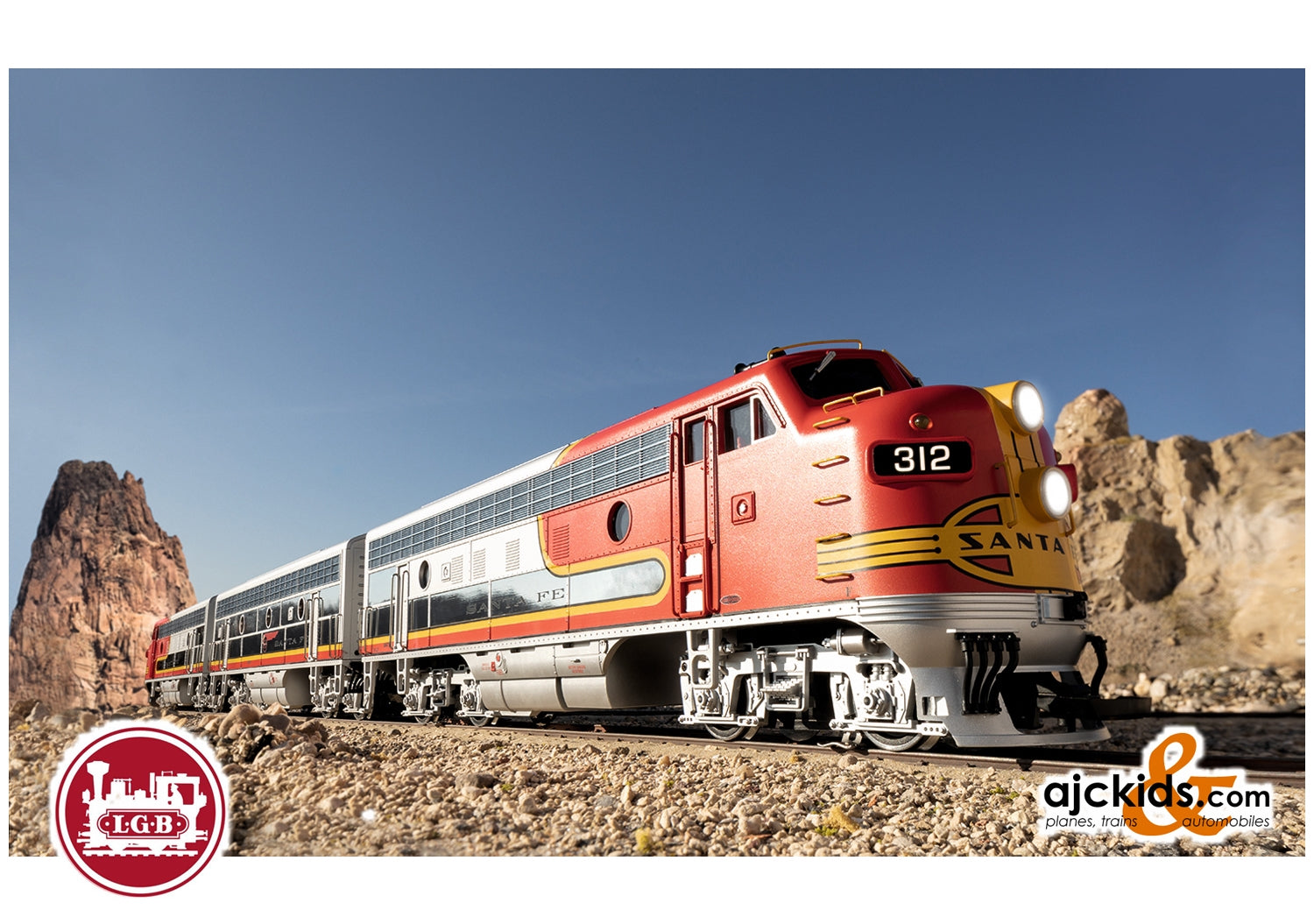LGB 20581 - Santa Fe F7A Diesel Locomotive
This is a model of an EMD F7 A unit diesel locomotive in an Atchison Topeka & Santa Fe Railroad version. The paint scheme and lettering are prototypical for Era III. The locomotive body is partially chrome-plated to show the original locomotive's typical stainless steel look.
Both trucks are driven by powerful Bühler motors with ball bearings. Traction tires. The locomotive has a built-in mfx/DCC decoder with many light and sound functions that can be controlled digitally. It also has a built-in plug connection on the back to power the speaker in the adjoining B unit from the decoder in the A unit. The locomotive has many separately applied details and the cab doors can be opened.
Length over the couplers 61 cm / 24".
Shortly after the end of World War Era_II, structural change was massively instituted on the American railroads. General Motors (GM) snapped up the largest piece of the cake with its subsidiary Electro-Motive Division (EMD), which was responsible for diesel locomotive production. To the horror of all steam locomotives, the legendary F7A/B was developed, built from 1949 to 1954, which triggered real declines among the black giants. All total 2,366 A units (with a cab) and 1,483 B units (without a cab) left the builder. This ensured them third place in the hit list of the most built American diesel locomotives. Their main area of use was pulling through freight trains as well as passenger trains. They were conversely less suited for local freight service with its extensive switching maneuvers. The frontend arrangement of the streamlined cabs greatly limited the view to the back. Yet just this cab in the "Bulldog" design became the unmistakable characteristic of this type, which still currently thrills railroad fans around the world.For the most part a series 567B 16-cylinder diesel motor with 1,521 horsepower (1,119 kilowatts) at 800 rpm supplied the drive for the F7. A DC generator mechanically coupled to the flywheel end of the motor powered the four traction motors, whereby each two-axle Blomberg truck was equipped with two motors.The Atchison, Topeka & Santa Fe Railway (AT&SF, Santa Fe for short) alone purchased 215 A units and 246 B units of the F7 between September of 1949 and May of 1953. Of these 57 locomotives with a cab and 88 units without a cab had the famous Warbonnet design in red, yellow, and silver. These units were used mainly to pull the Santa Fe passenger trains such as the famous Pullman train "Super Chief", which ran between Chicago and Los Angeles and was equipped from 1951 to the mid-Sixties with the F7. After its introduction in May of 1936, the "Super Chief" quickly advanced to "the" train between Chicago and Los Angeles, exactly like the deluxe train "20th Century Limited" of the New York Central Railroad, which was the preferred travel possibility of that time on the East Coast between New York and Chicago. The luxurious "Super Chief" was soon also considered after its introduction as "The Train of the Stars", because it was used by many prominent people and Hollywood celebrities such as Richard Burton and Elizabeth Taylor, Humphrey Bogart and Lauren Bacall, Dean Martin and Jerry Lewis, Desi Arnaz and Lucille Ball, James Cagney, Judy Garland, and Bing Crosby. It was also frequented by former Presidents Harry S. Truman and Dwight D. Eisenhower and their wives.
Charlie's Tip: The B unit to go with this locomotive is available under item number 20582, and another A unit with a different road number is available under item number 20583. A typical Era III express train, such as the famous "Super Chief", can be made with the new Santa Fe cars that are also available.
The body is partially chrome-plated to show the original locomotive's typical stainless steel look.
Running sounds will also work in analog operation.
Many light functions such as long distance lights or a Mars light.
mfx/DCC decoder and sound included
EAN/UPC: 4011525205814



